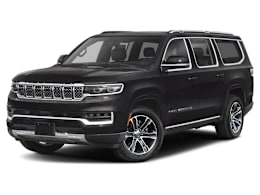Introduction
2022 Jeep Grand Wagoneer Is the Automakers 6-Figure Flagship
The full-sized SUV makes a statement with its luxurious interior, tech overload, prodigious power, and mammoth dimensionsOverview
To say the arrival of the 2022 Jeep Wagoneer and Grand Wagoneer was highly anticipated is doing little justice to these new SUVs. Jeep fans have been clamoring for the return of the Wagoneer, which was last produced in the 1991 model year, and the Jeep brand has desperately needed it. Since the easily forgotten Commander’s departure in 2010, Jeep has lacked a three-row model in its lineup. In addition, the brand has never had a true luxury flagship.
While the midsized segment void was addressed with the introduction of the Grand Cherokee L, the new Grand Wagoneer is positioned against other luxury three-row SUVs, such as the BMW X7, Cadillac Escalade, Infiniti QX80, Land Rover Range Rover, Lincoln Navigator, and Mercedes-Benz GLS. The less-expensive Wagoneer is targeted at the Chevrolet Tahoe, Ford Expedition, GMC Yukon, and Nissan Armada. The Wagoneer line is based on the Ram pickup truck, but rather than using the Ram’s solid-rear axle, it employs and independent rear suspension for a more refined ride.
After renting and driving a production version of the 2022 Jeep Grand Wagoneer from the automaker, we think that the SUV will be a highly competitive challenger to those models. The substantial SUV fills its generous interior with abundant luxury and technology features, produces big power from its massive V8 engine, delivers a driving experience that will fulfill the needs of its target audience, and includes the active safety and driver assistance systems that are, frankly, expected in this price range.
It’s a flashy-looking SUV, particularly the interior with its expanses of wood trim, leather-covered surfaces, and both piano-black and chrome-like details. The exterior and interior styling gives it the presence of being cooler than its competitors just because it’s a Jeep.
However, not all is rosy with the 2022 Grand Wagoneer. There are systems and features that are likely to bring frustration or discomfort, and the 6.4-liter V8 engine’s fuel economy isn’t wallet-friendly.
Whether it’s the 471 horsepower or the 455 lb.-ft. of torque, the 6.4-liter V8 in the Grand Wagoneer is a great engine. Paired with a smooth-shifting eight-speed automatic transmission, the big V8 delivers plentiful power at the slightest press of the accelerator pedal. It’s just as happy loafing around town as it is accelerating onto the highway, and the forceful exhaust note is in line with other Stellantis vehicles (such as the Ram 1500 pickup), which tend to have more aggressive exhaust tuning. Jeep says that when properly equipped, the Grand Wagoneer is capable of towing up to 9,850 pounds, while the Wagoneer—with its 392-hp, 5.7-liter V8—can tow up to 10,000 pounds.
Our rented Grand Wagoneer came equipped with Jeep’s Quadra-Lift air suspension, which has air springs at each corner to adjust for ride comfort and height by up to 3.6 inches. This is helpful in off-road use, when the SUV can be raised for additional clearance, as well as access, when the Grand Wagoneer can drop 1.6 inches to help with getting in and out of the cabin. It also contributed to the Jeep’s comfortable ride. The suspension did a very good job soaking up bumps and controlling body and ride motions. It felt more composed than the Cadillac Escalade we tested.























